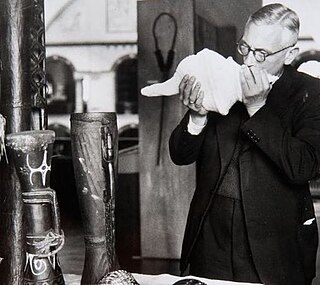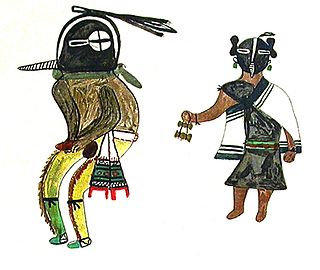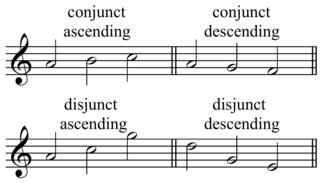Related Research Articles

Ethnomusicology is the multidisciplinary study of music in its cultural context, investigating social, cognitive, biological, comparative, and other dimensions involved other than sound. Ethnomusicologists study music as a reflection of culture and investigate the act of musicking through various immersive, observational, and analytical approaches drawn from other disciplines such as anthropology to understand a culture’s music. This discipline emerged from comparative musicology, initially focusing on non-Western music, but later expanded to embrace the study of any and all different kinds of music of the world.

Kokopelli is a fertility deity, usually depicted as a humpbacked flute player, who is venerated by some Native American cultures in the Southwestern United States. Like most fertility deities, Kokopelli presides over both childbirth and agriculture. He is also a trickster god and represents the spirit of music.

Indian Classical Music is the classical music of the Indian Subcontinent. It has two major traditions: the North Indian classical music known as Hindustani and the South Indian expression known as Carnatic. These traditions were not distinct until about the 15th century. During the period of Mughal rule of the Indian subcontinent, the traditions separated and evolved into distinct forms. Hindustani music emphasizes improvisation and exploration of all aspects of a raga, while Carnatic performances tend to be short composition-based. However, the two systems continue to have more common features than differences. Another unique classical music tradition from the eastern part of India is Odissi music, which has evolved over the last two thousand years.
Nordic folk music includes a number of traditions of Nordic countries, especially Scandinavian. The Nordic countries are Iceland, Norway, Sweden, Denmark and Finland.

Peyote songs are a form of Native American music, now most often performed as part of services in the Native American Church. They are typically accompanied by a rattle and water drum, and are used in a ceremonial aspect during the sacramental taking of peyote.

Indigenous music of North America, which includes American Indian music or Native American music, is the music that is used, created or performed by Indigenous peoples of North America, including Native Americans in the United States and Aboriginal peoples in Canada, Indigenous peoples of Mexico, and other North American countries—especially traditional tribal music, such as Pueblo music and Inuit music. In addition to the traditional music of the Native American groups, there now exist pan-Indianism and intertribal genres as well as distinct Native American subgenres of popular music including: rock, blues, hip hop, classical, film music, and reggae, as well as unique popular styles like chicken scratch and New Mexico music.
Regarding the music of Syria, there are certain musical traditions and practices that have been present in Syria longer than others. There have been musical influences introduced into Syria through multiple eras of conquest and influences from surrounding cultures in modern-day Syria. Lying near Egypt and Israel, and connected to southern Europe by the Mediterranean, Syria became host to many distinct cultural musics through trade and route. The music present in Syria is related greatly to poetry, influenced greatly by the Bedouin nomadic tribes, the maqam system in Arabic classical music, as well as influenced greatly by the geopolitical movement and conflict in the Middle East. Syrian music generally has a singer who is accompanied by three or four instruments. The texture is usually thin but can become denser depending on the use of each instrument. Music is tightly linked to poetry in Syria.
Indigenous music of Canada encompasses a wide variety of musical genres created by Aboriginal Canadians. Before European settlers came to what is now Canada, the region was occupied by many First Nations, including the West Coast Salish and Haida, the centrally located Iroquois, Blackfoot and Huron, the Dene to the North, and the Innu and Mi'kmaq in the East and the Cree in the North. Each of the indigenous communities had their own unique musical traditions. Chanting – singing is widely popular and most use a variety of musical instruments.
Blackfoot music is the music of the Blackfoot people. Singing predominates and was accompanied only by percussion.

Bruno Nettl was an American ethnomusicologist of Czech birth. A leading music researcher, Nettl was central in founding modern ethnomusicology. His research focused on folk and traditional music, specifically Native American music, the music of Iran and numerous topics surrounding ethnomusicology as a discipline.

Melodic motion is the quality of movement of a melody, including nearness or farness of successive pitches or notes in a melody. This may be described as conjunct or disjunct, stepwise, skipwise or no movement, respectively. See also contrapuntal motion. In a conjunct melodic motion, the melodic phrase moves in a stepwise fashion; that is the subsequent notes move up or down a semitone or tone, but no greater. In a disjunct melodic motion, the melodic phrase leaps upwards or downwards; this movement is greater than a whole tone. In popular Western music, a melodic leap of disjunct motion is often present in the chorus of a song, to distinguish it from the verses and captivate the audience.
The Arapaho are a tribe of Native Americans from the western Great Plains, in the area of eastern Colorado and Wyoming. Traditional Arapaho music, described by Bruno Nettl, includes sacred and secular songs. Traditional music uses terraced descent type melodic motion, with songs consisting of two sections, each with a range of more than an octave and scales of four to six tones.
Navajo music is music made by the Navajos, mostly hailing from the Four Corners region of the Southwestern United States and the territory of the Navajo Nation. While it traditionally takes the shape of ceremonial chants and echoes themes found in Diné Bahaneʼ, contemporary Navajo music includes a wide range of genres, ranging from country music to rock and rap, performed in both English and Navajo.
Incomplete repetition is a musical form featuring two large sections, the second being a partial or incomplete re-presentation or repetition of the first.
Yuman music is the music of Yumans, a group of Native American tribes from what is now Southern California and Baja California. They include Paipai, Havasupai, Yavapai, Walapai, Mohave, Quechan, Maricopa, Tipai-Ipai, Cocopa, and Kiliwa people. Folk songs in Yuma culture are said to be given to a person while dreaming. Many individuals who are in emotional distress go to a secluded area for a few weeks, there to receive new songs.

Anglo-American music is derived from the English culture of the Thirteen Colonies of the United States and has been a founding influence for American folk and popular music.

Natalie Curtis, later Natalie Curtis Burlin was an American ethnomusicologist. Curtis, along with Alice Cunningham Fletcher and Frances Densmore, was one of a small group of women doing important ethnological studies in North America at the beginning of the 20th century. She is remembered for her transcriptions and publication of traditional music of Native American tribes as well as for having published a four-volume collection of African-American music. Her career was cut short by her accidental death in 1921.

Art of the American Southwest is the visual arts of the Southwestern United States. This region encompasses Arizona, New Mexico, and parts of California, Colorado, Nevada, Texas, and Utah. These arts include architecture, ceramics, drawing, filmmaking, painting, photography, sculpture, printmaking, and other media, ranging from the ancient past to the contemporary arts of the present day.
A tetratonic scale is a musical scale or mode with four notes per octave. This is in contrast to a heptatonic (seven-note) scale such as the major scale and minor scale, or a dodecatonic scale, both common in modern Western music. Tetratonic scales are not common in modern art music, and are generally associated with prehistoric music.
A ditonic scale is a musical scale or mode with two notes per octave. This is in contrast to a heptatonic (seven-note) scale such as the major scale and minor scale, or a dodecatonic scale, both common in modern Western music. Ethnomusicologist Bruno Nettl noted that ditonic scales were common in many parts of the world but often limited to specific music types, such as children's songs, with the exception of some tribal societies.
References
- 1 2 Clint Goss (2011). "Zuni Sunrise - Sheet Music for Native American Flute" . Retrieved 2011-10-18.[ permanent dead link ]